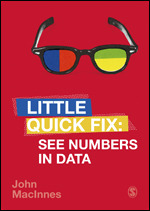See Numbers in Data
Little Quick Fix
- John MacInnes - University of Edinburgh, UK
Little Quick Fix
Quantitative/Statistical Research (General)
Little Quick Fix titles provide quick but authoritative answers to the problems, hurdles, and assessment points students face in the research course, project proposal, or design - whatever their methods learning is.
- Lively, ultra-modern design; full-colour, each page a tailored design.
- An hour's read. Easy to dip in and out of with clear navigation enables the reader to find what she needs - quick.
- Direct written style gets to the point with clear language. Nothing needs to be read twice. No fluff.
- Learning is reinforced through a 2-minute overview summary; 3-second summaries with super-quick Q&A
- DIY tasks create a work plan to accomplish a task, do a self-check quiz, solve a problem, get students to what they need to show their supervisor.
- Checkpoints in each section make sure students are nailing it as they go and support self-directed learning.
- How do I know I’m done? Each Little Quick Fix wraps up with a final checklist that allows the reader to self-assess they’ve got what they need to progress, submit, or ace the test or task.








